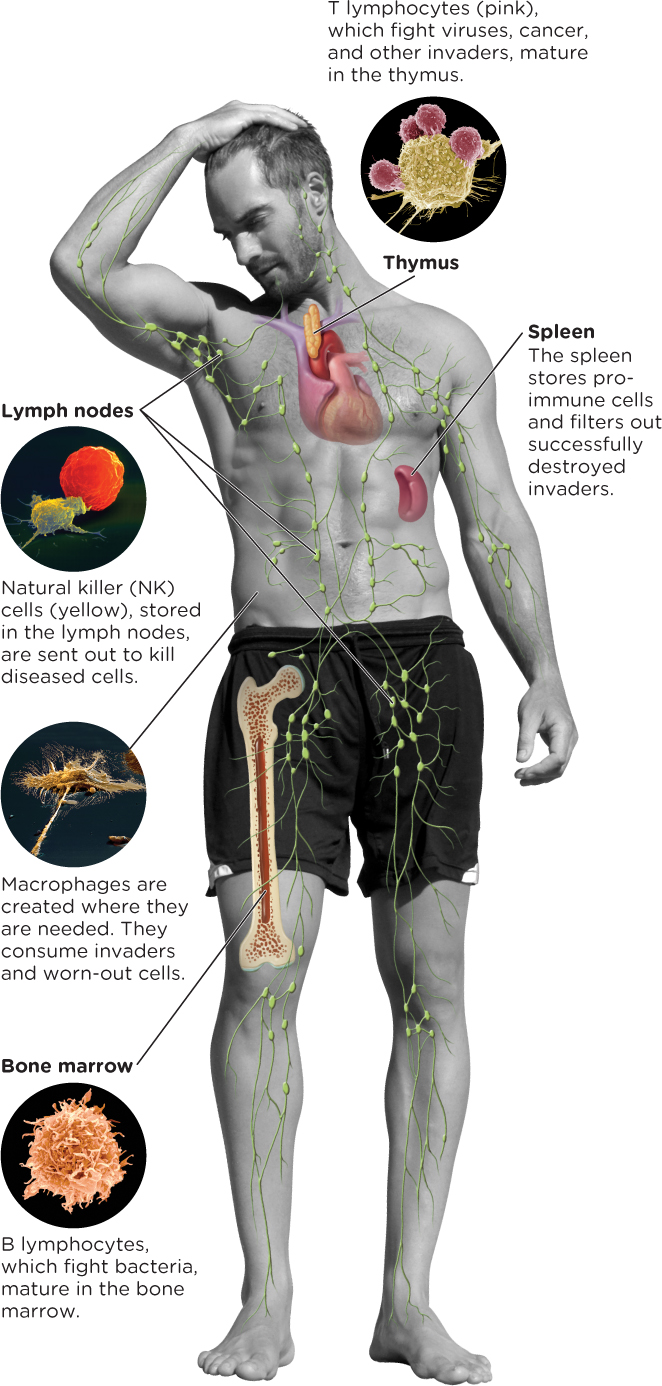12.3 Stress and Your Health
How does stress impact the lives of your relatives and friends? How does it affect you? Psychologists have spent decades examining how stress influences different people. In the early 1960s, the field of health psychology began to gather momentum. Many researchers began to explore the biological, psychological, and social factors contributing to illness and health. They wanted to understand how stress could be tempered and illness prevented.
Health psychology seeks to explain how our food choices, social interactions, and living environments affect our predispositions to illness and health. Researchers in this field contribute to health education, helping people develop positive eating and exercise habits; they also conduct public policy research that influences health-related guidelines. Health psychologists also study the impact of personality factors, coping style, cognitive appraisal, poverty, culture, social support, and religion—all topics addressed in this chapter.
Is Stress Making You Sick?
LO 7 Explain how stressors relate to health problems.
Before we explore the connection between stress and illness, we must understand how the body deals with illness in the first place. Let’s take a side trip into introductory biology and learn about the body’s main defense against disease—the immune system (Figure 12.3). The immune system is made up of the spleen, lymph nodes, and bone marrow. When disease-causing invaders threaten the body, the immune system deploys a special army of white blood cells called lymphocytes. Lymphocytes are produced in bone marrow, and their job is to battle enemies such as viruses and bacteria. When the body is expending its resources to deal with an ongoing stressor, the immune system is less powerful, and the work of the lymphocytes is compromised.

Like a platoon of soldiers, the immune system has a defense team to fight off invaders. Should the intruder(s) get past the skin, the macrophages (“big eaters”) are ready to attack. These cells hunt and consume invaders as well as worn-out cells in the body. Cells that have been infected by invaders, such as viruses and cancer, are the targets of natural killer cells (NK cells), which inject the compromised cells with a deadly chemical. In addition, NK cells release a protein that prevents the infection from spreading to other cells. In some cases, the body must call on its “special ops” teams. These are the B lymphocytes and T lymphocytes. The B lymphocytes (white blood cells) mature in the bone marrow and produce antibodies that chemically inhibit bacteria. The T lymphocytes (also white blood cells) mature in the thymus and play an integral role in fighting viruses, cancer, and other disease-causing agents that the B lymphocytes had not been successful in warding off (Straub, 2012).
Earlier we mentioned that stressors are correlated with health problems. But how exactly do stressors such as beliefs and attitudes affect the physical body? In other words, what is the causal relationship between stressors and illness? Let’s address this question by examining some illnesses thought to be closely linked to stressors (Cohen, Miller, & Rabin, 2001).
Gastric Ulcers and Stressors
Gastric ulcers have long been thought to be associated with stress, but the nature of this link has not always been clear. For many years, it was believed that stress alone caused gastric ulcers, but researchers then started to suspect other culprits. They found evidence that the bacterium H. pylori plays an important role. This does not mean that H. pylori is always to blame, however. Some people who carry the bacteria never get ulcers, while others develop ulcers in its absence. It seems that many factors influence the development of ulcers, among them tobacco use, family history, and excess gastric acid (Fink, 2011).

519
Cancer and Stressors
Cancer has also been linked to stress, both in terms of risk and development. Specifically, stress has been linked to the suppression of T lymphocytes and NK cells, which help monitor the body for immune system reactions to the invasion of developing tumors. Thus, when a person is exposed to stressors, the body is less able to mount an effective immune response, which increases the risk of cancer (Reiche, Nunes, & Morimoto, 2004).
In the United States and other Western countries, breast cancer is the greatest cancer risk for women, and some evidence suggests it is associated with stress. In a meta-analysis of 26 studies examining the association between life events and risk for breast cancer, death of a spouse was found to be modestly linked to the development of breast cancer; however, no other life events were related to increased risk (Duijts, Zeegers, & Borne, 2003). Other studies have found no association between life events and breast cancer risk (Roberts, Newcomb, Trentham-Dietz, & Storer, 1995).
Stress has been correlated with other types of cancer, though not always in the expected direction. Nielsen and colleagues (2008) examined the relationship between chronic daily stressors and the development of colorectal cancer using a prospective study in which nearly 12,000 Danes (who had never been diagnosed with colorectal cancer) were followed for 18 years. The researchers noted some surprising findings, particularly with respect to females. Women who reported higher levels of “stress intensity” and “daily stress” were less likely to develop colon cancer during the course of the study. In contrast, men with “high stress intensity” experienced higher levels of rectal cancer, although this association was not considered to be strong because only a small number actually developed this kind of cancer. The authors suggested that a variety of physiological, mental, and behavioral factors (for example, sex hormones, burnout, and increased alcohol intake) were involved in the relationship between high stress and lower rates of colon cancer in the women.
CONNECTIONS
In Chapter 6, we discussed the malleability of memory. Problems arise because many studies in this area ask participants to remember events and illnesses from the past. Here we are describing a prospective study, which does not require participants to retrieve information from the distant past, thus reducing opportunities for error.
Why can’t researchers agree on the link between cancer and stressors? Part of the problem is that studies are focusing on stressors of different durations. But as it turns out, short- and long-term stressors have distinct effects on the immune system (and thus its ability to combat cancer; Segerstrom & Miller, 2004). For short-lived stressors such as midterm exams, public speaking, and other activities lasting between 5 and 100 minutes, the body responds by increasing the number of NK cells and deploying other immune cells where needed. In other words, short-term stressors tend to augment immune functioning. The situation is quite different with long-term stressors such as military deployment or caring for someone with dementia, which are associated with decreases in NK cells. In order to appreciate the complex relationship between stress, immune function, and cancer, we must also consider biopsychosocial influences on a person’s response to stressors. Factors such as age, medical history, social support, and mental health can mediate the link between stressors and cancer (Reiche et al., 2004; Segerstrom & Miller, 2004).
Cardiovascular Disease and Stressors
The same is true for cardiovascular disease, which has also been linked to stressors. Dimsdale (2008) noted that over 40,000 citations popped up in a medical database when the search terms were “stress” and “heart disease.” What constitutes a stressor in this context? Earthquakes, unhappy marriages, and caregiving burdens are just a few stressors associated with a variety of outcomes or vulnerabilities, ranging from abnormalities in heart function to sudden death. Earlier we discussed socioeconomic status and stress; it turns out that both of those variables are factors in cardiovascular disease. Joseph and colleagues (2013) reported 5-fold higher odds of experiencing “cardiometabolic events” (within 5 years) for people who became unemployed as a result of Hurricane Katrina, a devastating natural disaster that occurred in 2005. The faster people get support to decrease “socioeconomic disruptions” related to a disaster, the better their health outcomes.
520
Other stressors have also been linked to heart disease. “Social-evaluative threats,” or concerns about being judged by others (about physical appearance or behaviors in a social context, for example), are associated with increases in blood pressure and consequently elevated risk of heart disease (Smith, Birmingham, & Uchino, 2012). One model suggests that increased job stress can put people at greater risk for developing coronary heart disease, particularly among those who perceive a significant degree of job “strain” resulting from high demands, lack of control, and other factors (Ferris, Kline, & Bourdage, 2012).
The mechanisms of the causal relationship between stressors and cardiovascular disease are not totally understood (Straub, 2012). However, we do know that an increase of fatty deposits, inflammation, and scar tissue within artery walls, that is, atherosclerosis, is a dangerous risk factor for stroke and heart disease (Go et al., 2013). With this type of damage, blood flow in an artery may become blocked or reduced. Researchers are not sure exactly how atherosclerosis starts, but one theory suggests that it begins with damage to the inner layer of the artery wall, which may be caused by elevated cholesterol and triglycerides, high blood pressure, and cigarette smoke (American Heart Association, 2012). It is important to note that stressors cannot be shown to cause changes in cardiovascular health (Dimsdale, 2008). Although there is a clear correlation between biopsychosocial stressors and cardiovascular disease, we cannot say with complete certainty that these stressors are responsible for the disease (Ferris et al., 2012).
Stress, Insidious Stress
Stress often exerts its harmful effects more indirectly (Cohen et al., 2001). During times of stress, we may sleep poorly, eat erratically, and perhaps even drink more alcohol. These behavioral tendencies can lead to significant health problems (Benham, 2010; Ng & Jeffery, 2003).

Smoking and Stress
In Chapter 4, on consciousness, we described how drugs are used to alleviate pain, erase memories, and toy with various aspects of consciousness. But a discussion of drugs is also in order here, because many people use drugs to ease stress. Smokers report that they smoke more cigarettes in response to stressors, as they believe it improves their mood. The association between lighting up and feeling good is one reason smokers have such a hard time quitting (Lerman & Audrain-McGovern, 2010). One study found that when participants were forced to abstain from smoking (for, say, a half day), their mood did improve when they finally puffed on a cigarette. However, this was the only stressful condition of the study in which smoking heightened mood; the effect was not observed when the participants were made to prepare for a public speaking task, for example (Perkins, Karelitz, Konklin, Sayette, & Giedgowd, 2010). Such findings are inconsistent with the self-reports of smokers, who claim that they smoke to feel better in a variety of stressful situations.
How do we get people to kick a habit that is perceived as so pleasurable? One effective way to help people reduce their smoking is to meet them where they are, rather than taking a one-size-fits-all approach (Mahoney, 2010; Prochaska, Velicer, Prochaska, Delucchi, & Hall, 2006). In other words, we should recognize that not all smokers need the same type of help. Some need help with smoking only; others engage in additional risky behaviors, like eating high-fat diets or getting too much sun. First-time quitters need different interventions than those who have quit before and relapsed. And success is more likely when the benefits and risks of smoking are made clear. For example, smokers often believe quitting will make them gain weight; therefore, they continue to smoke and don’t give enough thought to the serious risks of smoking. Gender is another important consideration, as women seem to be more susceptible to anxiety, depression, and perceived stressors when they fail to quit. Men, on the other hand, seem more vulnerable to cigarette cravings (Nakajima & al’Absi, 2012). This leads us to an important point: Do not underestimate the biology of nicotine addiction. Through tolerance, the body becomes dependent on the nicotine; the more you use it, the more you need to get the same effect.
521
CONNECTIONS
In Chapter 4, we discussed the concept of physiological dependence and tolerance. When we use drugs, such as nicotine, they alter the chemistry of the brain and body. Over time, the body adapts to the drug and therefore needs more and more of it to create the original effect.
Alcohol and Stress
Much the same could be said for alcohol, another drug frequently used to “take the edge off,” or counteract the unpleasant feelings associated with stress. Perhaps you know someone who “needs” a drink to relax after a rough day. Psychologists explain this type of behavior with the self-medication hypothesis, which suggests that people turn to drugs and alcohol to reduce anxiety (Swendsen et al., 2000).

Teenagers, in particular, appear to rely on alcohol to cope with daily hassles (Bailey & Covell, 2011). Adolescents frequently face disagreements with family members, teachers, and peers. They may worry about how they look and whether they are succeeding in school. We need to help adolescents find new and more “healthy” ways to handle these hassles in their lives. This means providing more support in schools, and perhaps educating teachers and counselors about the tendency to self-medicate with drugs and alcohol. Later we will discuss some positive coping strategies for teens and adults alike, but first let’s see how stress can be channeled in a way that promotes the health and well-being of others.
ADRENALINE JUNKIES
 What lures a person into an EMS career? The reward of alleviating human suffering is “incredible,” according to Kehlen. Imagine walking into the home of a diabetic who is lying on the floor, unconscious and surrounded by trembling family members. You insert an IV line into the patient’s vein and deliver D50, a dextrose solution that increases blood sugar. In a few moments, the person is awake as if nothing happened. The family is ecstatic; you have saved their loved one from potential brain damage or death. “People that like to do selfless acts, I think, are made for this job,” Kehlen says. And for those who enjoy a good challenge, an EMS career will not disappoint. Try working for 24 hours in a row, making life-and-death decisions, hoisting heavy bodies onto stretchers, and crouching over patients until your joints burn. This profession also provides a steady stream of intellectual stimulation. Medical treatments and patterns of illness and injury are constantly evolving. In the past, for example, ambulance crews rarely encountered accidents involving hybrid cars. Nowadays these electrical machines are all over the road, and prying them apart to rescue accident victims can be very dangerous. Rescuers must know exactly where to cut in order to avoid electrocution.
What lures a person into an EMS career? The reward of alleviating human suffering is “incredible,” according to Kehlen. Imagine walking into the home of a diabetic who is lying on the floor, unconscious and surrounded by trembling family members. You insert an IV line into the patient’s vein and deliver D50, a dextrose solution that increases blood sugar. In a few moments, the person is awake as if nothing happened. The family is ecstatic; you have saved their loved one from potential brain damage or death. “People that like to do selfless acts, I think, are made for this job,” Kehlen says. And for those who enjoy a good challenge, an EMS career will not disappoint. Try working for 24 hours in a row, making life-and-death decisions, hoisting heavy bodies onto stretchers, and crouching over patients until your joints burn. This profession also provides a steady stream of intellectual stimulation. Medical treatments and patterns of illness and injury are constantly evolving. In the past, for example, ambulance crews rarely encountered accidents involving hybrid cars. Nowadays these electrical machines are all over the road, and prying them apart to rescue accident victims can be very dangerous. Rescuers must know exactly where to cut in order to avoid electrocution.
But there appears to be something else drawing people into the EMS profession. You might call it the “adrenaline junkie” factor. Ever since Kehlen was a small boy, he enjoyed a certain amount of risk taking. He was the kid who fearlessly scaled the monkey bars and leaped off the jungle gym, and many of his colleagues claim they were the same way. “All of us probably thought we were 10 feet tall and made of steel,” Kehlen says, careful to note that “daring” is not the same as “reckless.” One must be calculating when it comes to determining what risks are worth taking.
522
The adrenaline junkie quality is also apparent in some police officers, according to Sergeant Michelle. An officer patrolling a city beat probably experiences the so-called adrenaline rush at least a few times per week. “When a hot call comes in, anyone worth their salt wants to go,” Sergeant Michelle explains (“hot call” meaning anything full of excitement and drama, like a robbery in progress). “You hope that the robbers are there,” she says, “and you get to arrest them.”
Is there really some common adrenaline junkie tendency among officers, EMS providers, and other first responders? That remains an open question. We do know, though, that first responders are frequently exposed to highly stressful events (Anderson, Litzenberger, & Plecas, 2002; Gayton & Lovell, 2012). With all this exposure to violence and trauma, how do the body and mind hold up? The answer is probably different for each individual, but constant stress certainly has the potential to erode health and well-being.
Too Much Cortisol
LO 8 List some consequences of prolonged exposure to the stress hormone cortisol.
Earlier we discussed the stress hormone cortisol, which plays an important role in mobilizing the body to react to threats and other stressful situations. Cortisol is useful if you are responding to immediate danger, like a raging fire or ruthless assailant. However, you don’t want cortisol levels to remain high for long. The body and brain are impacted when the cortisol system flips into overdrive.
Cortisol and Kids
The negative effects of stress are apparent very early in life—even before birth, in some cases. Increased levels of cortisol in mother and fetus can cause a variety of problems during pregnancy and after birth, including spontaneous abortion, preeclampsia, heart defects, and even preterm delivery (Mulder et al., 2002). Infants born to mothers subjected to natural disasters, trauma, and other extreme stressors are more likely to be born prematurely, have low birth weights, exhibit behavioral difficulties, and perhaps even show problems with cognitive development (Davis & Sandman, 2010; Tollenaar, Beijers, Jansen, Riksen-Walraven, & De Weerth, 2011). Field and Diego (2008) report that prenatal stressors are associated with fussing and crying, but this association might be indirect; such temperamental difficulties could be due to preterm birth (Baibazarova et al., 2013).

Now consider the types of stressors some preschool children confront every day. Research shows that conflicts at home can increase cortisol levels in children (Slatcher & Robles, 2012). Verbal exchanges such as the child exclaiming, “No! I don’t want to!” and parents saying, “You are going to shut your mouth and be quiet!” are exactly the types of conflicts associated with increased cortisol levels. Cortisol activity may help explain why exposure to conflict during childhood seems to pave the way for health problems (Slatcher & Robles, 2012). Clearly, cortisol plays a role in early development. But how does this stress hormone affect adults?
523
Cortisol On The Job
High cortisol levels can have life-or-death consequences, particularly for workers who make on-the-spot safety decisions. In one study, researchers had police officers participate in a realistic simulation of being targeted by shooters. Not only did the officers’ cortisol levels rise, but the functioning of their working memory decreased (Taverniers, Smeets, Van Ruysseveldt, Syroit, & von Grumbkow, 2011). Can you imagine the implications of being in a dangerous situation with impaired working memory? Think of the last time you were really afraid, and how difficult it was to think clearly. Your working memory was probably compromised.
CONNECTIONS
In Chapter 6, we presented the concept of working memory, which refers to how we actively maintain and manipulate information that is in short-term memory. Here, we see how these activities in working memory can be impacted by stressful situations.
Other research suggests that heightened cortisol levels may have the opposite effect. When police officers had to make threat-related decisions in a video simulation, they were better able to discern whether threatening individuals were armed when their cortisol levels were high. But this accuracy increased when the officer faced a simulation involving a Black suspect, and decreased when the suspect was White. This finding was the same for the White officers and minority officers participating in the study. The researchers concluded that higher cortisol levels, which were caused by the stressful situation, resulted in “heightened vigilance for danger” (Akinola & Mendes, 2012, p. 172). Apparently, the perceived threat of Black men was greater, which is consistent with what social psychologists have learned about the conscious and unconscious reactions many people have to racial minorities (Chapter 15).
Psychoneuroimmunology
We have now discussed some of the effects of short- and long-term stressors. You know that a spurt of cortisol gives you a boost in energy and alertness and steps up your immunity. You also know that if cortisol levels remain high for prolonged periods (as occurs with chronic stressors), the immune system may not function at an optimal level. We discussed how this affects one’s risk for developing gastric ulcers, cancer, and heart disease, but the list of negative health effects is much longer. According to a meta-analysis of over 300 studies, chronic stressors were found to be associated with problematic immune system responses, which may increase the risk for various illnesses involving inflammation, including multiple sclerosis, rheumatoid arthritis, asthma, and allergies (Segerstrom & Miller, 2004). The exact nature of these relationships is yet to be determined, but researchers are working hard to uncover them, including the impact of aging and vulnerable immune systems (Cohen et al. 2001). It is an exciting time for those who specialize in the field of psychoneuroimmunology  , which examines the relationships among psychological factors (such as coping, emotions, beliefs), the nervous system, and the functioning of the immune system.
, which examines the relationships among psychological factors (such as coping, emotions, beliefs), the nervous system, and the functioning of the immune system.
The field of health psychology, which draws on the biopsychosocial model and psychoneuroimmunology, has shed light on the complex relationship between stress and health (Havelka, Lucanin, & Lucanin, 2009). Now that we understand how profoundly stressors can impact physical well-being, let’s explore some real-life situations that can trigger stress.
show what you know
Question 12.9
1. When everyday stressors get to be too much, some people seek relief in alcohol. The __________ suggests that people turn to drugs and alcohol to ease anxiety.
Question 12.10
2. Infants born to mothers subjected to extreme stressors may be born prematurely, have low birth weights, and exhibit behavioral difficulties. These outcomes result from increased levels of the stress hormone _____________.
- H. pylori
- lymphocytes
- cortisol
- NK cells
Question 12.11
3. Why are people under stress more likely to get sick?
 CHECK YOUR ANSWERS IN APPENDIX C.
CHECK YOUR ANSWERS IN APPENDIX C.
524